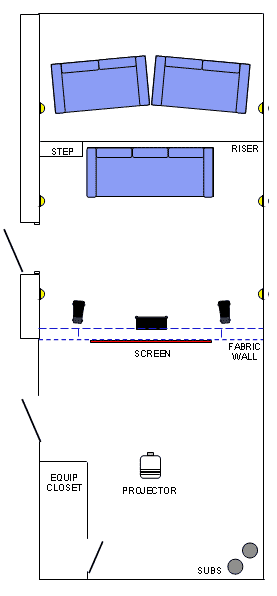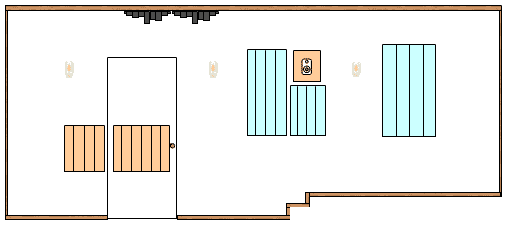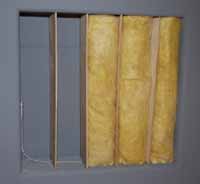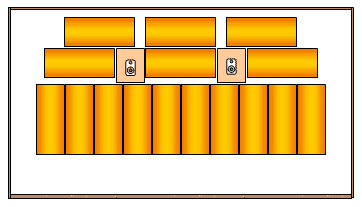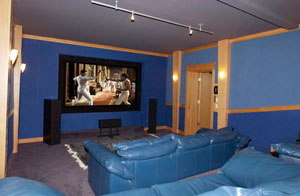|
Home Theater Design Designing a home theater from scratch
Room Dimensions The first thing we needed to decide was the room dimensions. I had three key goals for this theater which impact this decision:
In average size home theaters and listening rooms, the axial resonances (frequency at which the wavelength of the sound matches the room dimension) falls in the first few octaves of the audible sound spectrum. These resonances cause significant peaks and dips in the frequency response as heard in the room. To minimize the impact of these resonances, the room dimensions (length, width, height) are chosen so that they are not equal or an even multiple of one another. This essentially spreads out the resonances so that one frequency (or narrow range) is not affected by resonances along more than one room axis. I originally thought about building a room that had non-parallel walls. This would eliminate the strong axial resonances, at least along the width and length of the room (the axial resonance between the floor and ceiling would still exist assuming I couldn't use a sloped ceiling). After doing some research, I decided against this approach since rooms built like this tend to have poor imaging and are very hard to model. A rectangular room may have obvious bass resonance problems, but at least they are predictable and potentially easy to solve. A number of researchers have attempted to determine the optimal ratio for a rectangular room. The consensus is that there is no "optimal" ratio, but a number of different ratios that provide good distributions of room resonances. I originally chose a ratio (1.0 : 1.6 : 2.33) proposed by L. W. Sepmeyer (Computer Frequency and Angular Distribution of the Normal Modes of Vibration in Rectangular Rooms, 1965). However Dean suggested I make the wall between the theater and projection room acoustically transparent, effectively making the length of the room considerably longer. Larger rooms have fewer bass resonance problems because the modes are closer together in the audible frequency range. We're only increasing one of the room dimensions, but this is the most important dimension since this will make the bass response much smoother as we move forward and back in the room, giving us more flexibility in adjusting the seating positions. The effect of room modes can be reduced by using low frequency absorption in the room. This absorption broadens the bandwidth of each mode and reduces its amplitude. Low frequency absorption can be provided by appropriate room construction and using acoustic treatments designed for this purpose (such as RPG Modex panels and ASC Tube Traps, or similar homemade devices). A properly designed room with these treatments will result in a much smoother bass response, but more bass energy must be provided by the subwoofers to create the same bass loudness in the room. Increasing the length of the room also means that the rear wall is now a considerable distance from the speakers. This eliminates the rear room boundary from interfering with the front speaker response. Room boundaries can also have significant deleterious effect on frequency response smoothness. This is due to constructive and destructive interference between the direct sound from the speakers and the reflected sound from the walls. The projector room can also now be used for room acoustic treatments without worrying about esthetics. And the subwoofers can be placed in ideal positions to more evenly "load" the room so the bass response is more even throughout the entire listening area. The dimensions of the "theater" part of the room are 258" long, 178" wide, and 110" high. This room is separated from the projector room with a cloth partition. The length of the overall room is 442". Reverberation After considering room bass resonances, the most significant acoustical property of a room is its reverberation time. When a sound is generated in a room, it bounces around the room and eventually decays. The accepted definition of reverberation time is the time it takes sound to be attenuated by 60dB. In rough terms, this is the time it takes a loud sound to decay to inaudibility. A room with a long reverberation time will sound very live, perhaps even to the point of having echoes if the room is large enough. Many church cathedrals or gymnasiums will have this quality. A room with a very short reverberation time will sound dead and lifeless - an anechoic chamber or an open field are probably the best examples. There are many opinions about the optimum reverberation time for a home theater, but it is generally agreed that a reverberation time in the range of 0.2 to 0.6 seconds will work well. A longer reverberation time will make music sound more live, but at the expense of dialog intelligibility. Since movies are mostly about the dialog, I've designed the theater with a reverberation time goal of around 0.3 to 0.4 seconds. This is similar to my previous theater which worked very well. Reverberation time is determined by the size of the room and acoustic dampening. Acoustic dampening materials attenuate the sound as it reflects off the surface. Every material used in the room provides some acoustic dampening, so the challenge is to choose materials for their esthetic value that also provide good acoustical properties. For optimal sound, the reverberation time should be fairly consistent across the audible spectrum. It is fairly easy to absorb sound in the higher frequencies with materials such as carpeting, stuffed furniture, draperies, etc., but it is more difficult to match this absorption in the bass frequencies. The reverberation time can be approximated using the following simple formula, which was empirically derived by Sabine around the turn of the century. It should be noted, however, that this formula is not very accurate for small rooms, and empirical measurements will be required to fine tune the room. RT = 0.049V/Sa where, V = volume of the room in cu ft. S = total surface area of the room in sq ft. a = the average absorption coefficient of room surfaces. Sa = total absorption, sabins. The absorption coefficients of most building and acoustic materials are readily available. These are generally specified for six different frequencies (125Hz, 250Hz, 500Hz, 1KHz, 2KHz, and 4KHz). I created an excel spreadsheet for my theater to estimate the reverberation time based on the materials and room treatments I am planning to use. The determination of room treatments was partially determined by plugging their acoustical properties into this spreadsheet to see their effect. The calculated reverberation time for my theater ranges from 0.25 to 0.4 across the audio spectrum (at least from 125Hz to 4Khz). However, it is difficult to estimate the absorption that will result from the rear projector room. I modeled this as open space (i.e., high absorption across the spectrum), and this seems to have been fairly accurate since the reverberation time inside the theater sounds as I would have expected. Room Construction My two primary goals for room construction are noise isolation and good acoustical properties. Fortunately, conventional home building practices (specifically, drywall over framing) yield very good acoustics for small to moderate size rooms. My theater is being built in the basement of the house. The basement has a concrete slab which is generally not a favorable flooring material for a theater since it does not provide any low frequency absorption. To improve the acoustics, I had the floor built up with flooring plywood over 2x4 joists. Relatively thin (1/2") plywood is used for the floor to reduce the resonance frequency and increase low frequency absorption. Floor joists are spaced at random intervals through the room to vary the resonance frequencies. Closer spacing is used under higher traffic areas to firm up the floor. Sound absorbing material is used in between the floor joists. To reduce high frequency absorption from the carpet, vinyl sheeting is placed between the carpet and the pad on the rear shelf. The walls and ceiling are built using 5/8" drywall on framing which provides excellent acoustic properties (although some surface-applied acoustic treatment is still required for the best sound). My primary concern for the walls and floor construction is reducing sound transmission, both to avoid bothering family members outside the theater and to reduce ambient noise in the theater. Of the four walls, only one is shared with another living space in the house (two of the other three are outside walls, the other is shared with a storage room). The shared wall is built using double wall construction (two completely independent walls are built with an air gap separating them). This kind of wall construction provides more than 20dB of additional sound isolation compared to a normal stud partitioned wall. The drywall for this wall is mounted on hat channel using resilient sound isolation clips (RSICs - http://www.pac-intl.com) to further reduce sound transmission. The ceiling also uses 5/8" drywall mounted to hat channel using RSICs. 8" fiberglass batting with a 4" air gap is used between the floor joists. The ceiling is completely sealed to eliminate sound leakage. I had originally planned to use ceiling cans, but decided to switch to low voltage track lighting to avoid the challenges of acoustic sealing around the cans. Now that the theater is complete, I can assess how well these treatments worked. When movies and television is played at typical volume level, very little sound escapes the room. However, for movies with loud bass tracks (such as on movies like Saving Private Ryan), my subwoofers generate sufficient bass energy to cause noticeable rumbling on the floor above the theater. |
